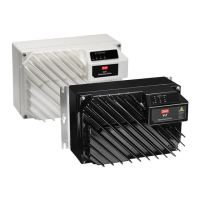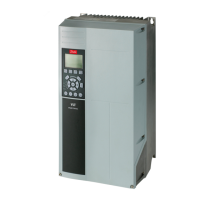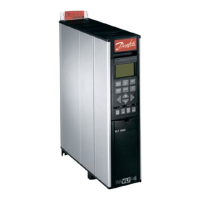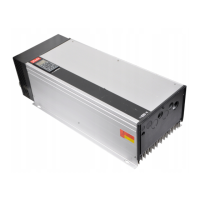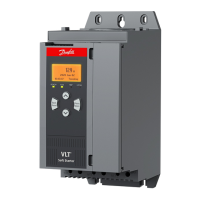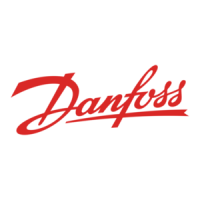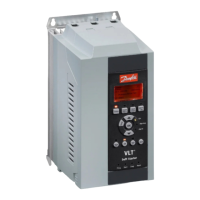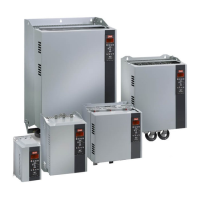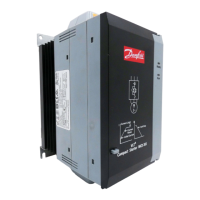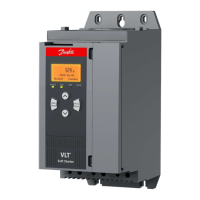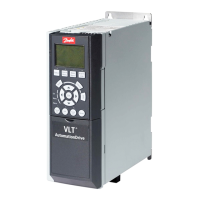
Do you have a question about the Danfoss VLT FC 302 and is the answer not in the manual?
| Brake Function | Built-in brake chopper in all units up to 22 kW |
|---|---|
| Output Voltage Range | 0-100% of input voltage |
| Power Range | 0.37 kW |
| Control Modes | VVCplus, Flux, U/f |
| Protection Features | Overvoltage, undervoltage, overcurrent, short circuit, overtemperature, overload |
| Communication Options | Modbus RTU, BACnet, Ethernet/IP, Profinet, Profibus, CANopen, DeviceNet |
| Ambient Temperature Range | -10°C to +50°C (derating above +40°C) |
| Enclosure Rating | IP20, IP21, IP55 |
| Cooling Method | Air-cooled |
| Input Voltage | 200-240V, 380-480V, 525-600V |
Covers essential safety precautions for operating frequency converters, emphasizing high voltage hazards and safe handling procedures.
Details electrical installation procedures, including general cable information, EMC considerations, and specific wiring instructions.
Provides a pre-start checklist for inspecting auxiliary equipment, cable routing, control wiring, cooling, EMC, fusing, grounding, and wiring.
Details procedures for applying power, including safety warnings, voltage checks, and ensuring operator devices are off.
Explains basic operational programming, including entering motor data and selecting setup methods like SAS or manual procedures.
Guides on performing a local control test of the motor and system, noting caution for motor start and checking acceleration/deceleration problems.
Outlines the recommended procedure for system start-up after wiring and programming are complete, including applying external run commands.
Explains how to use the Graphical Local Control Panel (GLCP), detailing its display sections, menu keys, and navigation.
Introduces programming the frequency converter, focusing on Quick Setup Parameters for optimal operation.
Lists and explains essential Quick Setup parameters like Language, Motor Power, Voltage, and Current.
Details basic setup parameters including Motor Speed Unit, and provides notices on changing these settings.
Details methods for implementing motor thermal protection using PTC sensors, KTY sensors, ETR calculation, or mechanical thermal switches.
Covers controlling electro-mechanical brakes in hoisting applications, including parameter settings for release and activation speeds.
Lists various functions that can be assigned to digital inputs, including Start, Stop, Reversing, and Brake control.
Lists available functions for relays and digital outputs, covering status indications, alarms, torque limits, and bus control.
Guides on programming the active filter, recommending changing nominal voltage and ensuring auto mode.
Organizes parameters into groups for easy selection, covering operation, load, motor, brake, references, limits, and communication.
Organizes parameters into groups for easy selection, covering operation, load, motor, brake, references, limits, and communication.
Covers parameters for load and motor settings, including general settings, motor selection, and detailed motor data.
Details parameters for setting references, ramps, and jog speeds, enabling flexible control inputs.
Covers parameters for setting limits and warnings related to motor operation, speed, current, and reference signals.
Lists parameters for configuring digital inputs and outputs, including their functions, terminals, and modes.
Details parameters for analog inputs and outputs, covering voltage/current ranges, filtering, and scaling.
Explains parameters for PID controllers and advanced process control functions, enabling precise regulation.
Covers parameters for communication settings, including FC ports, bus protocols (Profibus, CAN, Ethernet), and general options.
Explains parameters for Smart Logic Control, including SLC settings, comparators, logic rules, and states for custom automation.
Details parameters for special functions like inverter switching, mains on/off, trip resets, current limit control, and energy optimizing.
Illustrates connection examples for motor control using external signals like start/stop, speed up/down, and potentiometer reference.
Defines various status messages related to operation mode, reference site, and operating status of the frequency converter.
Differentiates between warnings (impending conditions) and alarms (tripped conditions), and explains alarm trip-lock.
Provides detailed definitions for specific warnings and alarms, including causes and troubleshooting steps.
Lists and defines warnings and alarms specific to the active filter, including their causes and remedies.
Guides on initial start-up and operation, with a checklist for pre-start inspections and troubleshooting common issues like display or motor problems.
